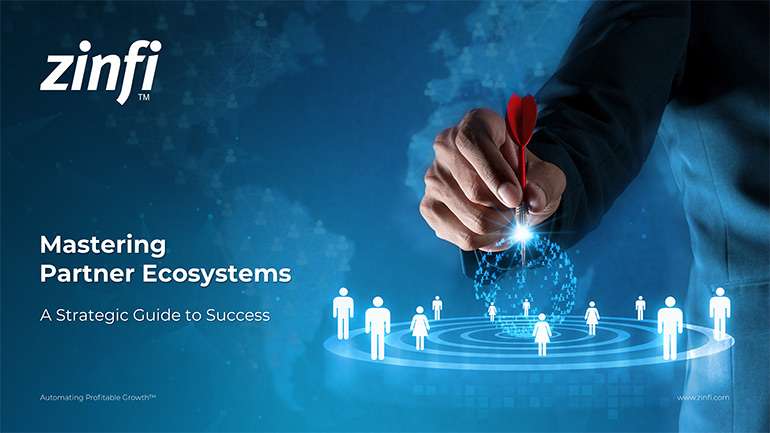Best Practices Articles

Is Your Channel Sales Motion Choppy?
A well-run channel can produce a consistent sales motion that will not only drive profitable growth, but also help an organization establish a significant competitive advantage. However, building a channel sales motion that is not choppy requires a highly structured approach. Basically, you need to do a few things right in a very organized way. If your company is struggling to figure out why your channel sales are choppy, read on.
In a previous article entitled “5 Factors That Affect Channel Sales,” I explored McKinsey’s 7-S Framework to discuss strategy, structure, systems, staffing and skills that can impact sales positively or negatively. In this article, I continue to explore the foundations of channel sales, but here I shift the focus to the specific factors that can make channel sales choppy. Let’s start with a few common issues that can undermine the consistency of your channel sales motion.- Seasonality – If your products are services tied to seasons—whether natural (winter, spring, summer, fall) or social (tax seasons, wedding seasons, etc.)—then chances are you have a naturally choppy channel sales motion. The best way to balance this is to do business in different hemispheres (e.g., the US and Australia) or in different countries that have different social seasons. Another way to overcome seasonality is to expand your product portfolio. For example, if you are in tax services, expand into financial services to help even out the highs and lows of the tax services business.
- Motions – If you do not have your people, processes and programs aligned to address channel partners’ core business needs, it is almost impossible to build a repeatable channel sales motion. Instead, you’ll find yourself pursuing random quarterly activities, and you will soon feel like you are always fighting fires. In that case, it is hardly surprising to see your channel sales to go up and down. The only way to change this is to take a properly aligned, long-term approach.
- Products – At the end of the day, what you sell is what determines your relationship with your channel partners. If your product is out of touch with market demands, is becoming stale or is simply losing its utility, your channel sales are likely to turn spotty. While you may not have an immediate fix—after all, product development is a long-term game—you can try to linearize your sales by exploring other channels where viable competition may not be present yet. When Chiquita selected convenience stores as a new way to distribute bananas as a snack the company not only expanded its channel sales, but also achieved multifold increases in its product margins.
- Programs – Channel sales is all about building repeatable “coin-operated” motions, assuming you have a strong product and a compelling value proposition. Just like a direct sales team, sales teams are driven by the prospect of financial gain. Therefore, properly structured channel programs can have a significant impact on channel sales, provided they are designed with partner business needs in mind. The potential for profitability is always a key driver for channel sales. That means that programs not only need to directly address a partner company’s financial needs, but also the needs of sales reps at the partner organization. Properly structured compensation and incentives programs should address both the needs of the partner organization and its individual salespeople.
Best Practices Guidebook
 How to Start and Scale Partner Ecosystems Best Practices
How to Start and Scale Partner Ecosystems Best PracticesDownload Guide
 The Evolution of PartnerOps: Past, Present & Future Best Practices
The Evolution of PartnerOps: Past, Present & Future Best PracticesDownload Guide
 Mastering Channel Sales: Strategies, Best Practices, and Growth Tactics for 2025
Mastering Channel Sales: Strategies, Best Practices, and Growth Tactics for 2025Download Guide
 Winning with Partner Advisory Councils: Best Practices for Partner Engagement & Growth
Winning with Partner Advisory Councils: Best Practices for Partner Engagement & GrowthDownload Guide
 The Future of Partner Ecosystems Best Practices
The Future of Partner Ecosystems Best PracticesDownload Guide
 The AI Revolution: How Technology and Talent are Shaping the Future
The AI Revolution: How Technology and Talent are Shaping the FutureDownload Guide
 Top 105 Partner Management Metrics that Matter Best Practices
Top 105 Partner Management Metrics that Matter Best PracticesDownload Guide
 Mastering PRM Integration Best Practices
Mastering PRM Integration Best PracticesDownload Guide
 Building a Sales Partner Portal with Salesforce Best Practices
Building a Sales Partner Portal with Salesforce Best PracticesDownload Guide
 Building and Managing Partner Ecosystems Best Practices
Building and Managing Partner Ecosystems Best PracticesDownload Guide
 Mastering Co-Marketing and Co-Selling Best Practices
Mastering Co-Marketing and Co-Selling Best PracticesDownload Guide
 Transforming Partner Ecosystems Best Practices
Transforming Partner Ecosystems Best PracticesDownload Guide
 Mastering Partner Ecosystems Best Practices
Mastering Partner Ecosystems Best PracticesDownload Guide
 Mastering Partner Onboarding Best Practices
Mastering Partner Onboarding Best PracticesDownload Guide
 Partner Ecosystem Management Best Practices
Partner Ecosystem Management Best PracticesDownload Guide
 B2B Marketing in the Age of Intelligence Best Practices
B2B Marketing in the Age of Intelligence Best PracticesDownload Guide
 Multi-Partner Co-Selling Best Practices
Multi-Partner Co-Selling Best PracticesDownload Guide
 A Guide to Enhance Channel Sales Efficiency
A Guide to Enhance Channel Sales EfficiencyDownload Guide







